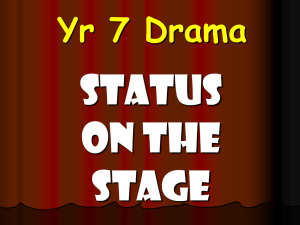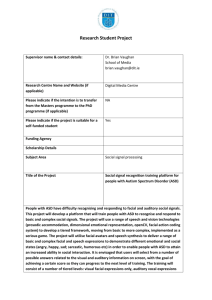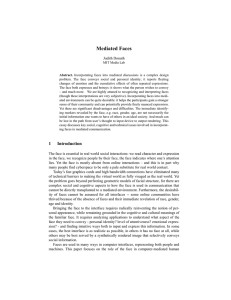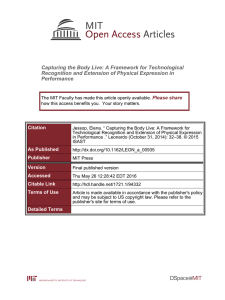santorini-emotion-wp6-modeling - AAAC emotion
advertisement
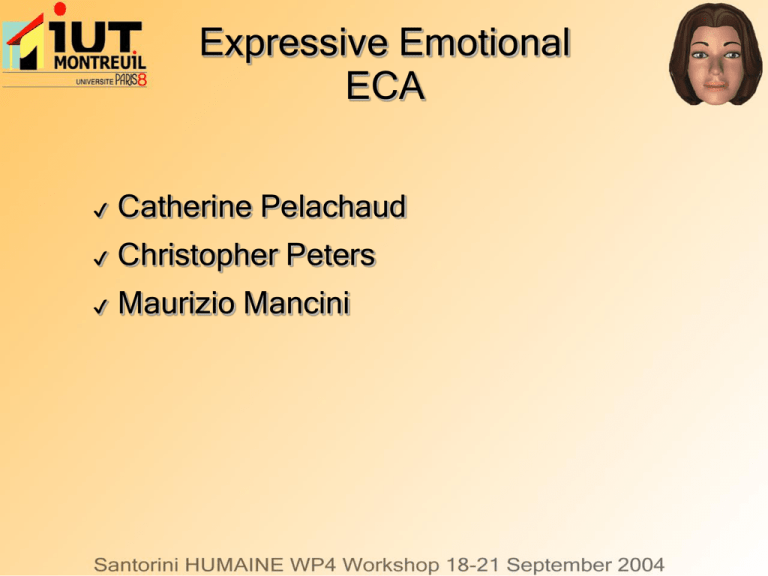
Expressive Emotional ECA ✔ Catherine Pelachaud ✔ Christopher Peters ✔ Maurizio Mancini Expressive Emotional ECA ✔ ✔ Emotion behavior modeling: ✔ Signals ✔ Temporal course of signals ✔ Expressive qualities Often in ECA systems: ✔ only modeling of signals is considered ✔ 6 ‘universal’ expressions Large variety of facial expressions (Kollias et al) ✔ Archetypal expressions modeling using FAPs MPEG-4 ✔ Estimation of the range of variations of FAPs in archetypal expressions ✔ Intermediate expressions: rule-based computational model based on ✔ Whissell’s representation: ✔ ✔ Activation, evaluation, Plutchik’s angular measure Laban Movement Analysis ✔ ✔ 5 major components: ✔ Body: part of the body in used ✔ Space: description of the directions and paths of motion ✔ Shape: changing forms of the body ✔ Effort: dynamics of the body moves ✔ Relationship: modes of interaction with oneself, others and the environment (facing, contact…) Textual and symbolic language of movement description EMOTE (Badler et al) EMOTE model for Effort and Shape ✔ Based on Movement Observation Science ✔ Laban Movement Analysis ✔ Computational model of Effort and Shape components ✔ Effort ✔ Four motion factors: space, weight, time, flow Space ✔ Weight ✔ Time ✔ Flow ✔ ✔ Each factor ranges from: Indulging in the quality ✔ Fighting against the quality ✔ Effort ✔ Space: indirect direct ✔ ✔ Weight: light strong ✔ ✔ Feather movement punching Time: sustained sudden ✔ ✔ Waving away bugs pointing to a particular spot Stretching grabbing a falling object Flow: free bound ✔ Waving widely moving in slow motion Shape ✔ Three distinct qualities of change in the form of movement: Shape flow: mover’s attitude toward the changing relationship among body parts ✔ Directional movement: mover’s intent to bridge the action to a point in the environment ✔ Shaping: mover’s carving or molding attitude with the environment ✔ Shape ✔ Three dimensions: ✔ Horizontal: spreading enclosing ✔ ✔ Vertical: rising sinking ✔ ✔ Opening arms to embrace clasping someone in a hug Reaching for something in a high shelf stamping the floor with indignation Sagittal: advancing retreating ✔ Reaching out to shake hand Avoiding a punch Expressive Communicative Gestures (Hartmann et al) ✔ Expressivity parameters: ✔ ✔ ✔ ✔ ✔ ✔ ✔ Spatial: amplitude of movement Temporal: duration of movement Power: dynamic property of movement Fluidity: smoothness and continuity of movement Repetitiveness: tendency to rhythmic repeats Overall Activation: quantity of movement across modalities Expressivity modeling: modal and intermodal Emotional Modeling • Carmen's Bright IDEAS ( Stacy Marsella, USC) • Interactive drama • Agent exhibits gestures based on their emotional states and personality traits FantasyA (Ana Paiva, Inesc) • Role-playing game • The emotion detected from user drives the behavior of one of the agents in the video game SenToy (Ana Paiva, Inesc) • SenToy is a tangible interface device, used to influence emotional behaviour in FantasyA • SAFIRA: EU project Behavior Modeling ✔ Facial expression: ✔ Use facial analysis techniques/motion capture to look at: ✔ Value of facial animation parameters (muscular contraction, FAP…) ✔ Pattern of movement for a given parameter ✔ Relation of facial animation parameters within a same expression ✔ Coarticulation of movements between expressions Mocap Mocap FAPs – MPEG-4 Example Gesture ✔ Gesture specification often based on sign language gesture specification: ✔ ✔ ✔ ✔ ✔ ✔ Hand description Palm orientation Wrist position Movement: wrist, elbow, finger… Parameters characterizing quality of movement: Laban, sub-set…? Parameters act on overall animation (Emote) or on gesture phases (preparation, stroke, …)? Behavior ✔ Gaze: ✔ ✔ Body: ✔ ✔ Direction, gaze length, mutual gaze, ratio of gaze avoidance/gaze look at Body posture, overall movement quality Voice: ✔ Paralinguistic parameters ✔ Text Signals analysis/generation ✔ Use analysis method to: ✔ Get information on parameters ✔ Multimodal integration ✔ Signals synchrony across modalities ✔ Build computational model for generation ✔ Get the expressive quality of behavior ✔ Signals generation should not be done on one frame only but on a temporal interval Conclusion ✔ Emotion is shown through: ✔ Signals ✔ Their temporal course ✔ Which parameters to look at? Which are the perceptually relevant ones? ✔ How to describe: ✔ The signals? ✔ Their evolution through time? ✔ Correlation between modalities? Conclusion ✔ Relation between intensity of emotion and behaviors? ✔ Selection of behaviors ✔ Quality of behaviors ✔ Duration of behaviors ✔ Behaviors across modalities


